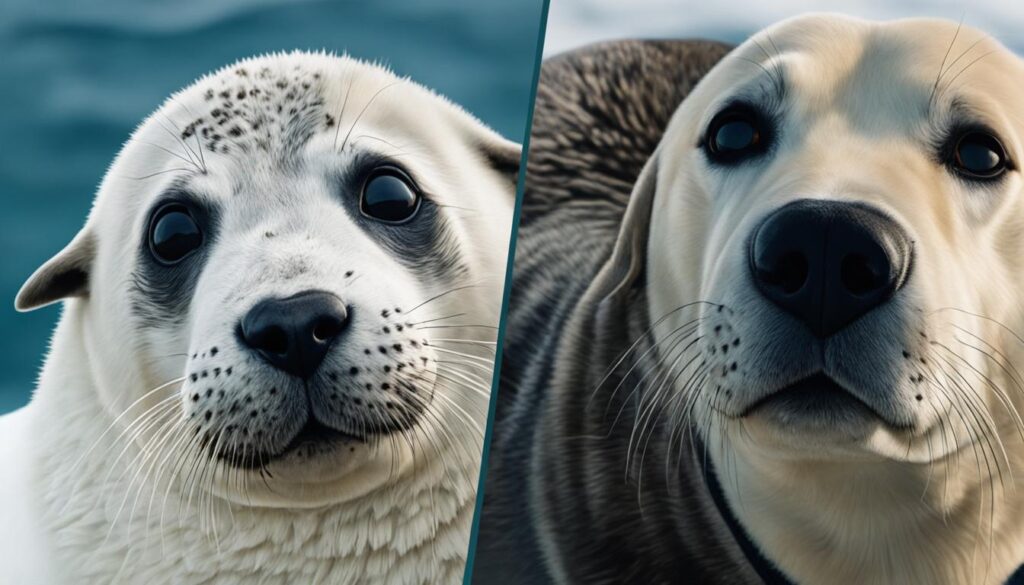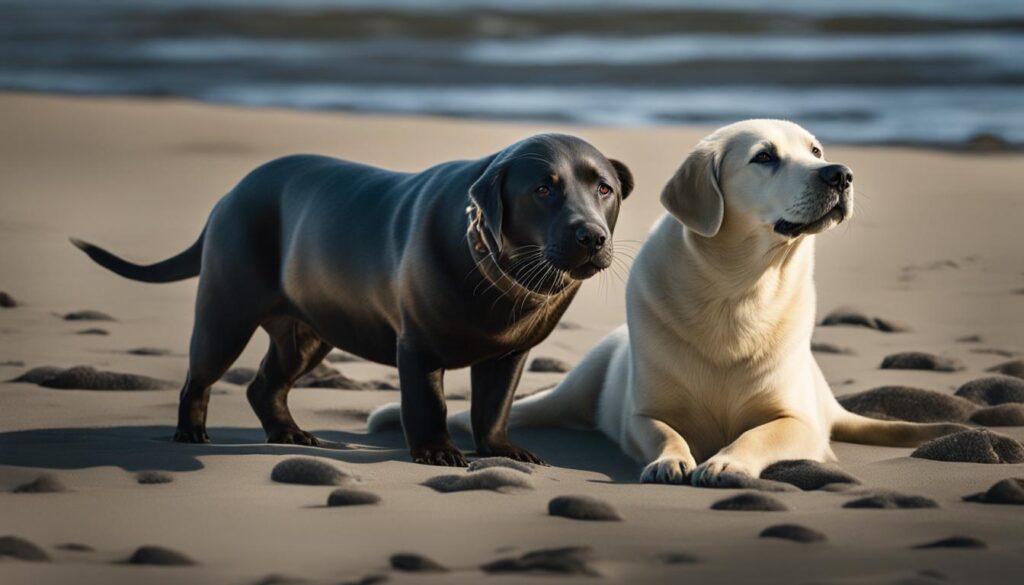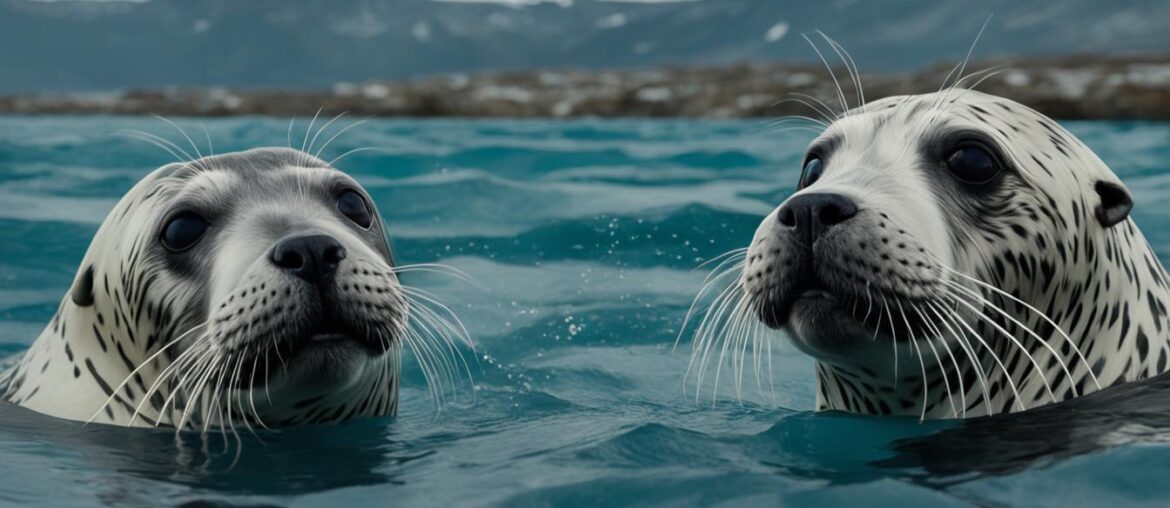When it comes to seals and dogs, many people can’t help but notice the striking similarities between these two creatures. From their adorable, whiskered faces to their playful and sometimes mischievous nature, it’s easy to wonder if there’s a deeper connection between these charismatic animals. In this article, I aim to explore the relationship between seals and dogs, shedding light on their fascinating evolutionary history and the factors that contribute to their similarities.
Key Takeaways:
- Seals and dogs belong to different families, but they share a common ancestor that lived 55 million years ago.
- Seals are members of the Pinnipedia family, while dogs belong to the Canidae family.
- Both seals and dogs have evolved distinct adaptations and lifestyles over millions of years.
- While seals have adapted to an aquatic lifestyle with flippers for swimming, dogs have remained terrestrial animals specialized for running and digging.
- Although seals and dogs share some physical and behavioral similarities, they have unique characteristics that make them distinct species.
Evolutionary Connection

The evolutionary connection between seals and dogs is a fascinating aspect of their shared history. While they belong to different families, both seals and dogs can trace their roots back to common ancestors that lived millions of years ago. This evolutionary connection provides insights into the dynamic relationship between these two distinct yet related species.
Seals, members of the family Pinnipedia, have evolved from terrestrial carnivores that gradually adapted to an aquatic lifestyle. Over time, these ancestral carnivores developed specialized features and behaviors to thrive in the marine environment. Their limbs transformed into flippers, allowing for efficient swimming and navigation through water. This adaptation is crucial for pursuing prey and evading predators in their aquatic habitats.
On the other hand, dogs are domesticated descendants of wolves. Domestication began thousands of years ago when humans and wolves developed mutually beneficial relationships. Through selective breeding, humans shaped the traits and behaviors of wolves, ultimately leading to the establishment of various dog breeds around the world. Despite their different lineage, dogs retain genetic similarities to their wolf ancestors.
Although seals and dogs diverged along separate evolutionary paths, they both belong to the larger category of mammals. This common classification signifies shared genetic traits and physiological characteristics. Through DNA analysis and scientific research, scientists have uncovered the genetic link between seals and dogs, further strengthening the understanding of their evolutionary connection.
Genetic Similarities
Genetic studies have revealed commonalities between seals and dogs that stem from their shared ancestry. While the specific genetic connections are complex, several fundamental genetic traits connect these animals. These similarities include common genetic sequences and structures that have been passed down through generations, shaping their physical and behavioral traits.
| Seals | Dogs |
|---|---|
| Belong to the family Pinnipedia | Descendants of wolves |
| Evolved from terrestrial carnivores | Domesticated over thousands of years |
| Modified limbs into flippers for swimming | Retain limbs for running and digging |
| Strategize hunting techniques in aquatic environment | Utilize inherited instincts for hunting and companionship |
The table above highlights key differences and similarities between seals and dogs, showcasing how their species-specific adaptations have shaped their evolutionary trajectories.
Physical Similarities

Although seals and dogs belong to different families, they do share some physical similarities. Both animals have four limbs, but seals have modified their limbs into flippers for swimming, while dogs use their limbs for running and digging. Seals and dogs also have streamlined bodies suited to their respective lifestyles. Additionally, both animals have whiskers and share adaptations such as thick layers of blubber or fur coats to protect them from the elements.
These physical similarities reflect the evolutionary histories of seals and dogs. While seals have adapted to an aquatic environment, dogs have evolved to thrive on land. These adaptations have shaped their bodies to facilitate movement and survival in their specific habitats.
Both seals and dogs possess limbs, which are integral to their locomotion. However, seals have transformed their limbs into flippers, providing them with exceptional swimming abilities. These modified flippers enable seals to navigate through the water with agility and precision, allowing them to catch prey efficiently and evade predators.
In contrast, dogs have retained their limbs for terrestrial movement, utilizing them for running, jumping, and digging. Their limbs have evolved to support fast movements, endurance, and the ability to traverse various terrains. This adaptation aligns with dogs’ hunting instincts and their ability to chase down prey or track scents, showcasing their versatility and agility on land.
In terms of body structure, both seals and dogs exhibit streamlined forms ideal for their respective lifestyles. Seals have sleek, torpedo-shaped bodies, minimizing water resistance as they glide through the ocean. Their streamlined bodies reduce drag, enabling them to swim swiftly and efficiently, conserving energy during long underwater pursuits.
Dogs, on the other hand, possess muscular bodies designed for agility and speed on land. Their streamlined physique allows them to run swiftly, change directions rapidly, and maintain balance, whether pursuing prey or engaging in playful activities. The streamlined body structure of both seals and dogs reflects their evolutionary adaptations for efficient movement within their habitats.
Whiskers are another physical similarity shared by seals and dogs. Whiskers, also known as vibrissae, serve as sensory organs that provide valuable information about the environment. Seals and dogs utilize their whiskers to navigate in darkness, detect the proximity and movement of objects, and explore their surroundings.
Moreover, seals and dogs possess adaptations to protect themselves from the elements. Seals have thick layers of blubber, which act as insulation, keeping them warm in cold waters and helping them to retain heat. Similarly, dogs have fur coats that provide insulation and protect them from temperature extremes, ensuring their comfort in various climates.
In conclusion, seals and dogs may belong to different families, but they exhibit notable physical similarities. They share modified limbs, streamlined body structures, whiskers, and protective adaptations. These physical similarities reflect the evolutionary paths and adaptations of seals and dogs, enabling them to excel in their respective environments.
Behavioral Similarities

Seals and dogs share remarkable behavioral similarities that highlight their social nature and hunting prowess. Both species exhibit social behavior, living in groups and relying on each other for protection and companionship. They communicate through vocalizations and body language, enabling effective interaction within their respective communities.
When it comes to hunting, seals and dogs demonstrate impressive skills and techniques. They leverage their physical abilities and intelligence to catch prey and ensure their survival in their natural habitats. Whether in water or on land, both animals employ a variety of hunting techniques, including stalking, chasing, and ambushing, to secure their next meal.
Comparison of Social Behavior and Hunting Techniques
| Behavior | Seals | Dogs |
|---|---|---|
| Social Nature | Seals are highly social animals, often forming large colonies and engaging in cooperative behaviors to ensure their safety and well-being. | Dogs are pack animals, known for their strong social bonds and their ability to work together in various tasks. |
| Communication | Seals communicate through vocalizations such as barks, growls, and trills, as well as body language such as posturing and gesturing. | Dogs use a range of vocalizations, including barking, howling, and whining, along with body language cues like tail wagging, ear position, and facial expressions. |
| Hunting Techniques | Seals employ different hunting techniques depending on their species and habitat. These techniques include stealthy approaches, rapid pursuit in water, and strategic positioning to ambush prey. | Dogs utilize various hunting techniques, showcasing their agility and intelligence. These techniques include tracking scents, chasing down prey, and using their natural instincts to corner and capture targets. |
Genetic Link

DNA analysis and scientific studies have provided compelling evidence of a genetic link between seals and dogs. These studies have revealed that seals and dogs share a common ancestor that existed approximately 55 million years ago, suggesting a long history of evolutionary connection. Despite their distinct physical characteristics and lifestyles, the genetic similarities between these two species are notable, indicating a close relationship.
Scientists have conducted extensive research comparing various aspects of seals and dogs, ranging from behavior and anatomy to genetics, physiology, and ecological roles. These studies have shed light on the genetic makeup of both species, unraveling the unique adaptations and traits that have emerged over millions of years.
By examining the DNA of seals and dogs, researchers have unraveled the intricate genetic code that underlies their similarities and differences. This molecular analysis has helped scientists uncover the intricate evolutionary pathways that led to the development of these distinct yet connected species.
Furthermore, genetic studies have provided valuable insights into the shared traits and characteristics between seals and dogs. These findings have not only deepened our understanding of the genetic link between these species but also highlighted their remarkable ability to adapt and thrive in their respective environments.
In conclusion, DNA analysis and scientific studies have established a convincing genetic link between seals and dogs. These studies have unraveled the fascinating evolutionary history that connects these seemingly different creatures, showcasing the intricate workings of nature’s genetic tapestry.
| Aspect | Seals | Dogs |
|---|---|---|
| Family | Pinnipedia | Canidae |
| Common Ancestor | Shared ancestor existed around 55 million years ago | Shared ancestor existed around 55 million years ago |
| Genetic Differences | Relatively small, indicating a close genetic relationship | Relatively small, indicating a close genetic relationship |
| Research Areas | Behavior, anatomy, genetics, physiology, ecological roles | Behavior, anatomy, genetics, physiology, ecological roles |
Seals and Dogs in the Wild
Seals and dogs have adapted to different environments. Seals are marine mammals that can thrive in both fresh and saltwater habitats. They have specific adaptations that enable them to survive in water and spend their lives in specific areas, such as coastal regions and polar waters.
Dogs, on the other hand, are primarily land animals but have the ability to swim. While not perfectly suited for an aquatic lifestyle, dogs can navigate through water and enjoy swimming activities. They have adaptations that support life on land, such as running and digging, which allow them to explore and thrive in diverse terrestrial environments.
Although their environments differ, both seals and dogs are highly adaptable creatures that have successfully inhabited various parts of the world. While seals are predominantly found in colder regions, including the Arctic and Antarctic, dogs can be found across many continents and climates, from deserts to snowy mountain ranges.
Let’s take a closer look at the adaptations and characteristics of seals and dogs in their respective environments:
Seals in the Wild
Seals have evolved a range of adaptations that enable them to thrive in their marine habitats. These adaptations include:
- Streamlined bodies and flippers for efficient swimming and maneuvering through water.
- Thick layers of blubber to provide insulation and store energy.
- Webbed feet that aid in propulsion and diving.
- Excellent diving abilities, with some species capable of reaching depths of several hundred meters.
These adaptations allow seals to navigate through their watery environment, find food, and evade predators such as sharks and killer whales. Seals are highly skilled swimmers and are well adapted to the challenges presented by their marine habitats.
Dogs in the Wild
Dogs, being primarily land animals, have adaptations that support their survival in terrestrial environments. These adaptations include:
- Well-developed muscles and bones for running, jumping, and agility.
- Sharp teeth and powerful jaws for capturing and eating prey.
- Keen senses, including excellent hearing and a keen sense of smell.
- Paws designed for efficient movement on various surfaces, allowing them to traverse different terrains.
While not as specialized for aquatic life as seals, some dog breeds are natural swimmers and can enjoy water-based activities. However, their primary habitat remains on land, where they exhibit a wide range of behaviors, including hunting, foraging, and socializing.
| Seals in the Wild | Dogs in the Wild |
|---|---|
| Adaptations for swimming, diving, and moving efficiently in water. | Adaptations for running, jumping, and moving efficiently on land. |
| Marine mammals with habitats mostly in coastal regions and polar waters. | Primarily land animals with habitats across various terrains and climates. |
| Thick layers of blubber for insulation and energy storage. | Muscular bodies and sharp teeth for hunting and capturing prey. |
| Webbed feet and streamlined bodies for efficient swimming. | Paws designed for movement on different surfaces. |
Comparing Intelligence

Assessing intelligence in animals can be a complex task, as it depends on various factors and criteria. When it comes to seals and dogs, both species exhibit remarkable cognitive abilities and problem-solving skills.
Seals, despite being marine mammals, have shown surprising intelligence in their hunting techniques and adaptability. Studies have revealed that grey seals, for instance, are even better than dogs at following human signals, showcasing their ability to comprehend and respond to complex commands.
On the other hand, dogs are often regarded as highly intelligent due to their unique capacity to form emotional bonds and communicate effectively with humans. Their social behavior and natural obedience provide them with problem-solving skills within a human-led context.
While dogs may excel in their interaction with humans, seals’ ability to thrive in challenging aquatic environments and develop innovative hunting strategies demonstrates their remarkable intelligence in their own domain.
“Seals and dogs possess different types of intelligence, shaped by their respective environments and evolutionary adaptations.” – Dr. Jane Williams, Animal Behavior Specialist
Comparing the intelligence of seals and dogs ultimately reveals the fascinating diversity of cognitive abilities among different species. While dogs may exhibit remarkable domestic intelligence, seals demonstrate their own extraordinary problem-solving skills and adaptability within aquatic ecosystems.
| Intelligence Traits | Seals | Dogs |
|---|---|---|
| Social intelligence and communication | ✓ | ✓ |
| Problem-solving skills | ✓ | ✓ |
| Adaptability to their respective environments | ✓ | ✓ |
| Ability to comprehend and respond to human signals | ✓ | ✓ |
| Uniqueness of intelligence within their evolutionary context | ✓ | ✓ |
Why Seals Look Like Dogs

Seals and dogs share striking similarities in their appearance, which can be attributed to their shared ancestry genes. These resemblances can often lead to the misconception that seals and dogs are closely related. When it comes to physical features, both seals and dogs possess skull structures and facial characteristics that bear a resemblance to each other, including jaws, teeth, whiskers, and fur.
Despite these similarities, it’s important to note that seals and dogs belong to different families and have distinct evolutionary paths. The resemblance in their appearances is a result of convergent evolution, where unrelated species develop similar traits as a response to similar environmental conditions or adaptations.
While seals have adapted to thrive in aquatic environments, dogs have evolved to excel in terrestrial habitats. Despite these differences, their shared ancestral genetic makeup explains the physical similarities observed between them. Their common ancestry is believed to date back millions of years, but their respective evolutionary journeys have led them down separate paths.
Genetic Connection
Through DNA analysis and scientific research, it has been confirmed that seals and dogs share a common ancestor from around 55 million years ago. This genetic link further supports the physical similarities observed between these fascinating creatures.
Understanding the reasons behind the similarities in appearance between seals and dogs provides valuable insights into the diversity of life on Earth. It showcases the power of evolution and how different species can develop analogous traits despite their distinct evolutionary trajectories.
Now that we’ve explored the intriguing visual parallels between seals and dogs, let’s delve into other aspects of their relationship, such as their size and weight differences, in the next section.
Seals and Dogs: Size and Weight Differences
When comparing seals and dogs, one prominent difference is their size and weight. Seals, like the mighty elephant seal, can reach staggering weights of up to 4500 pounds, making them some of the largest marine mammals in existence. On the other hand, even the largest dog breeds, such as the St. Bernard or the English Mastiff, typically weigh around 300 pounds at most.
These size and weight differences can be attributed to the distinct evolutionary paths and adaptations of seals and dogs to their respective environments. Seals have evolved to thrive in the aquatic realm, where their larger size and bulk can provide advantages such as buoyancy and thermal insulation. Dogs, however, have adapted to various terrestrial habitats, where agility and efficiency in movement often take precedence over sheer mass.
| Species | Weight (pounds) |
|---|---|
| Elephant Seal | Up to 4500 |
| St. Bernard | Around 300 |
| English Mastiff | Around 300 |
Environmental Impacts and Conservation
Seals and dogs have distinct roles in their respective ecosystems, requiring specific conservation efforts to protect their environments and ensure their long-term survival.
Conservation Efforts for Seals
Seals, as important marine mammals, are subject to conservation efforts aimed at understanding their populations, migration patterns, and the threats they face. These efforts involve monitoring seal populations, studying their behavior and habitat requirements, and implementing measures to mitigate human-related impacts.
Conservation organizations and researchers work diligently to protect seal populations from overfishing, habitat destruction, pollution, and disturbances caused by human activities. By studying seals’ natural history and ecology, conservationists can determine the best strategies for preserving their populations and ensuring their role in maintaining healthy marine ecosystems.
Managing Environmental Interactions with Dogs
Dogs, as domesticated animals, can impact local ecosystems through their interactions with wildlife. While dogs provide companionship and support to humans, it is essential to manage their interactions to prevent negative impacts on the environment.
Unleashed dogs can disturb wildlife by chasing, harassing, or even preying on vulnerable species. Dogs can also introduce diseases or parasites to wildlife populations. To protect local ecosystems, designated areas or controlled access should be implemented to minimize potential conflicts between dogs and wildlife.
Furthermore, responsible pet ownership, including activities such as proper waste disposal and the use of leash laws, can help reduce the potential environmental impacts of dogs and maintain the ecological balance of natural areas.
Environmental Pollutants and Seal Health
Seals can be exposed to various pollutants in their environment, including polychlorinated biphenyls (PCBs) and dioxins. These contaminants can accumulate in their bodies, leading to adverse health effects.
Research and monitoring programs focus on understanding the impacts of these pollutants on seal populations and designing strategies to mitigate their effects. These measures may include regulating industrial discharges, improving waste management practices, and educating the public about the importance of reducing pollution in marine ecosystems.
To better visualize the environmental impacts and conservation efforts relating to seals and dogs, the table below summarizes their roles, challenges, and conservation initiatives:
| Seals | Dogs |
|---|---|
|
|
|
|
|
Exposure to pollutants such as PCBs and dioxins |
|
|
Wrapping Up
After exploring the relationship between seals and dogs, it is clear that although they share a common ancestor, they have evolved to become distinct species with unique adaptations and lifestyles. While seals and dogs may have some physical and behavioral similarities, such as four limbs and social behaviors, they ultimately belong to different families and have their own characteristics.
Studying the similarities and differences between seals and dogs provides valuable insights into their evolutionary history and the diverse range of life on Earth. It deepens our understanding of how species can adapt and thrive in different environments over millions of years.
In conclusion, while seals and dogs may look alike at first glance, their relationship is rooted in a shared ancestry rather than a direct connection. Recognizing and appreciating the differences between these two fascinating species enriches our knowledge of the natural world and the incredible diversity of life forms that exist.
FAQ
Are seals and dogs related?
Seals and dogs have a common ancestor, but they belong to different families. Seals are part of the Pinnipedia family, while dogs are members of the Canidae family.
What is the evolutionary connection between seals and dogs?
Seals and dogs share a common ancestor that lived 55 million years ago. Seals evolved from terrestrial carnivores that adapted to an aquatic lifestyle, while dogs are domesticated descendants of wolves.
What physical similarities do seals and dogs have?
Seals and dogs have four limbs, streamlined bodies, whiskers, and protective adaptations like thick layers of blubber or fur coats.
Do seals and dogs exhibit similar behaviors?
Yes, seals and dogs are social creatures that live in groups, communicate through vocalizations and body language, and are skilled hunters using techniques like stalking and ambushing.
Is there a genetic link between seals and dogs?
DNA analysis and scientific studies have confirmed that seals and dogs share a common ancestor. Their genetic differences are relatively small, indicating a close genetic relationship.
How do seals and dogs adapt to their environments?
Seals are marine mammals adapted to living in water, while dogs are primarily land animals that can swim. They have different adaptations for survival in their respective environments.
How do seals and dogs compare in terms of intelligence?
Seals are surprisingly intelligent, with unique hunting techniques and problem-solving skills. Dogs are often seen as more intelligent due to their ability to form emotional bonds and communicate with humans.
Why do seals and dogs look similar?
Seals and dogs share physical similarities due to shared ancestry genes. They have skull structures, facial features, jaws, teeth, whiskers, and fur that resemble each other.
How do seals and dogs differ in size and weight?
Seals, such as the elephant seal, can weigh up to 4500 pounds, while some large dog breeds only weigh around 300 pounds. The size and weight differences are due to their different adaptations and evolutionary paths.
What are the environmental impacts and conservation efforts for seals and dogs?
Seals are important marine mammals, and conservation efforts focus on understanding their populations, migration patterns, and threats they face. Dogs, as domesticated animals, can have interactions with wildlife that need to be managed to protect local ecosystems.






